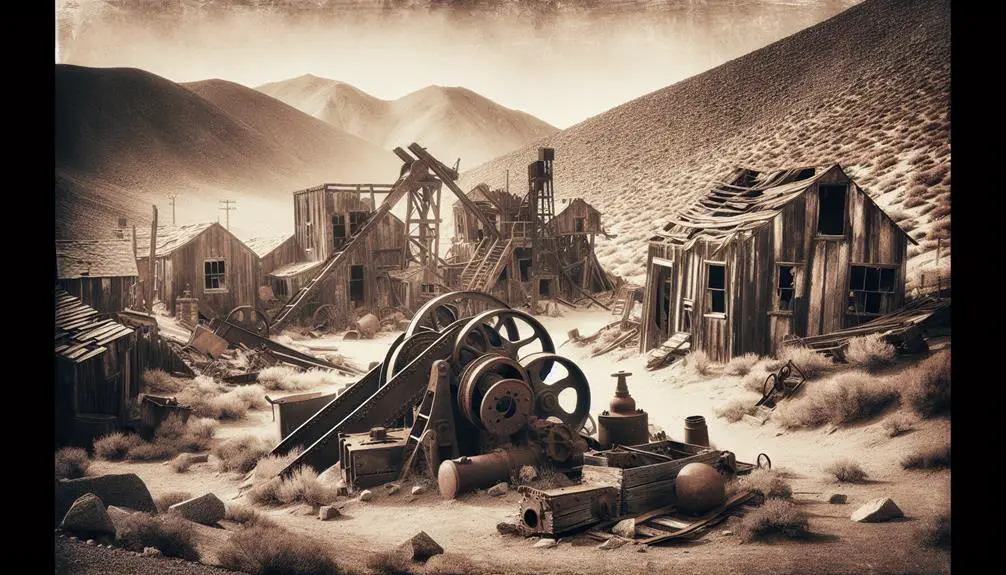Discover the fate of lost mining camps in the US. Camps rose during resource booms, but economic shifts and environmental harm led to their decline. Social bonds formed among miners, traders, and workers. Gold Rushes fueled town growth, leaving a lasting cultural legacy. The industry’s downturns and regulations caused many sites to be forsaken. Preservation initiatives aim to keep their history alive and attract tourists for economic revival. Uncover the intriguing journey of these ghostly remnants in the American West today.
Key Points
- Rapid growth and decline due to economic shifts and resource demands.
- Abandonment from environmental degradation and economic challenges.
- Impact of Gold Rushes led to economic boosts but subsequent challenges.
- Decline of mining industry due to economic downturns and regulations.
- Preservation efforts and tourism for historical significance and economic growth.
Rise and Fall of Mining Camps
During the 19th and 20th centuries, mining camps in the US experienced rapid growth and subsequent decline due to fluctuating resource demands and economic factors. Social dynamics within these camps were characterized by a diverse mix of individuals seeking economic opportunities, leading to the formation of tight-knit communities. Miners, merchants, and laborers all played pivotal roles in shaping the social fabric of these camps, with relationships often defined by shared hardships and camaraderie.
Economic shifts, such as changes in commodity prices and advancements in mining technology, heavily influenced the fortunes of these camps. Booms and busts were common occurrences, with periods of prosperity quickly followed by downturns as resource veins were depleted or new mining sites discovered elsewhere. The transient nature of mining work meant that populations in these camps fluctuated greatly, contributing to the ebb and flow of social dynamics.
As the demand for certain resources waned or economic conditions shifted, many mining camps faced abandonment as inhabitants sought opportunities elsewhere. This cycle of growth and decline was emblematic of the volatile nature of the mining industry during that era.
Factors Contributing to Abandonment
The decline of mining camps in the US can be attributed to various factors that ultimately led to their abandonment. Environmental degradation played a significant role in the abandonment of mining camps. The intensive mining activities often resulted in deforestation, water contamination, and soil erosion, making the areas less habitable over time. As the environmental conditions deteriorated, it became increasingly challenging for miners and their families to sustain a livelihood in these areas.
Moreover, economic instability also contributed to the abandonment of mining camps. Fluctuating commodity prices, high production costs, and market saturation were common issues faced by mining communities. When the profitability of mining operations decreased, many miners were forced to leave the camps in search of better opportunities elsewhere. The combination of environmental degradation and economic challenges created a difficult environment for sustaining the mining camps, ultimately leading to their abandonment.
Impact of Gold Rushes on Settlements
The Gold Rushes drastically altered the landscape of settlements in the United States, reshaping communities and economies in a rapid and unprecedented manner. The influx of people seeking fortunes in gold led to the rapid development of towns and cities in previously uninhabited regions. This surge in population brought diverse cultural heritage to these areas, creating a rich tapestry of traditions and beliefs.
The economic impact of the Gold Rushes was profound. The sudden increase in wealth flowing into these settlements boosted local economies, leading to the establishment of businesses catering to the needs of miners and settlers. However, with the eventual decline of gold reserves, many settlements faced economic challenges as miners moved on to new gold strikes, leaving behind ghost towns that once thrived with activity.
Despite the transient nature of many settlements born from the Gold Rushes, their cultural heritage remains embedded in the history of the American West, serving as a reminder of the transformative power of these historic events.
Decline of Mining Industry
As the demand for traditional resources wanes and environmental concerns heighten, the mining industry is experiencing a notable decline in activity and profitability. Economic downturns have played a significant role in this decline, causing many mining operations to scale back or cease production altogether. Additionally, stringent environmental regulations have been put in place to mitigate the negative impact mining activities can have on ecosystems and surrounding communities.
Due to these factors, many mining companies are facing increased operational costs and regulatory hurdles, making it harder for them to sustain profitable operations. As a result, some mines have been forced to close down, leading to abandoned mining camps scattered across the country. The decrease in mining activity has also had ripple effects on local economies that were once heavily reliant on the industry for jobs and revenue.
In this changing landscape, the future of the mining industry remains uncertain as companies navigate the challenges posed by environmental regulations and economic uncertainties.
Preservation Efforts and Tourism
With the decline of mining activities across the US due to economic challenges and environmental regulations, a shift towards preservation efforts and tourism is emerging in abandoned mining camp areas. Conservation initiatives play an essential role in maintaining the historical significance of these sites. By safeguarding old structures, artifacts, and stories, these initiatives guarantee that the legacy of mining communities isn’t forgotten.
Tourism development in these areas offers opportunities for economic growth. Visitors interested in history and adventure are drawn to explore the remnants of the mining camps, contributing to the local economy. The influx of tourists can create jobs, stimulate businesses, and revitalize these once-forgotten regions.
The economic impact of promoting tourism in former mining camp locations can be substantial. By leveraging the historical charm and unique stories of these areas, communities can attract visitors, generate revenue, and support ongoing preservation efforts. This symbiotic relationship between preservation and tourism not only preserves the past but also paves the way for a sustainable future.
Frequently Asked Questions
How Did the Presence of Native American Communities Impact the Development and Abandonment of Mining Camps in the Us?
The presence of Native American communities greatly influenced the development and eventual abandonment of mining camps in the US. Impact of displacement and cultural assimilation shaped the interaction dynamics, contributing to the complex history.
What Role Did Environmental Factors, Such as Natural Disasters or Resource Depletion, Play in the Decline of Mining Camps?
Do climate effects and economic factors lead to the demise of mining camps? Was land degradation a catalyst for community displacement? Environmental changes and resource exhaustion played pivotal roles, reshaping the once thriving mining landscapes.
Were There Any Notable Instances of Conflict or Violence Between Different Groups Within Mining Camps?
In mining camps, conflicts often arose due to competing interests. Community dynamics played an important role in conflict resolution. Understanding diverse perspectives and fostering communication were essential for maintaining peace. Cooperation and respect were key values in managing disputes.
How Did the Establishment of Railroads and Other Transportation Networks Influence the Rise and Fall of Mining Camps?
Railroad expansion during the 19th century transformed mining camps into bustling economic hubs. The ease of transportation increased access to resources, leading to rapid growth. However, as railroads shifted, some camps declined, emphasizing the volatile nature of economic development.
What Impact Did Changes in Government Policies or Regulations Have on the Abandonment of Mining Camps in the Us?
Government regulations greatly impacted the abandonment of mining camps in the US. Economic downturns often led to stricter policies, making operations less profitable. As rules tightened, many camps couldn’t adapt, ultimately forcing their closure and the desertion of miners.



